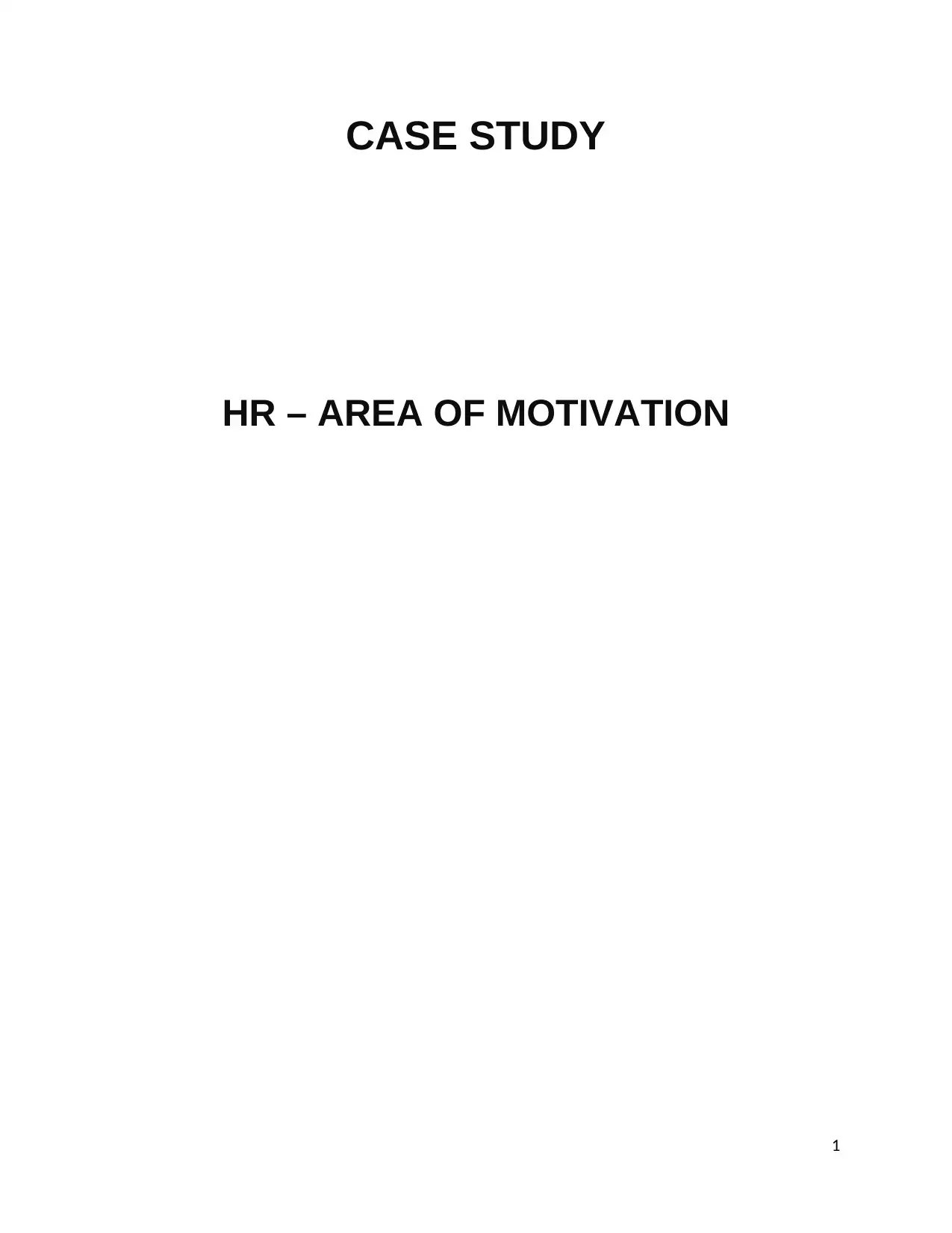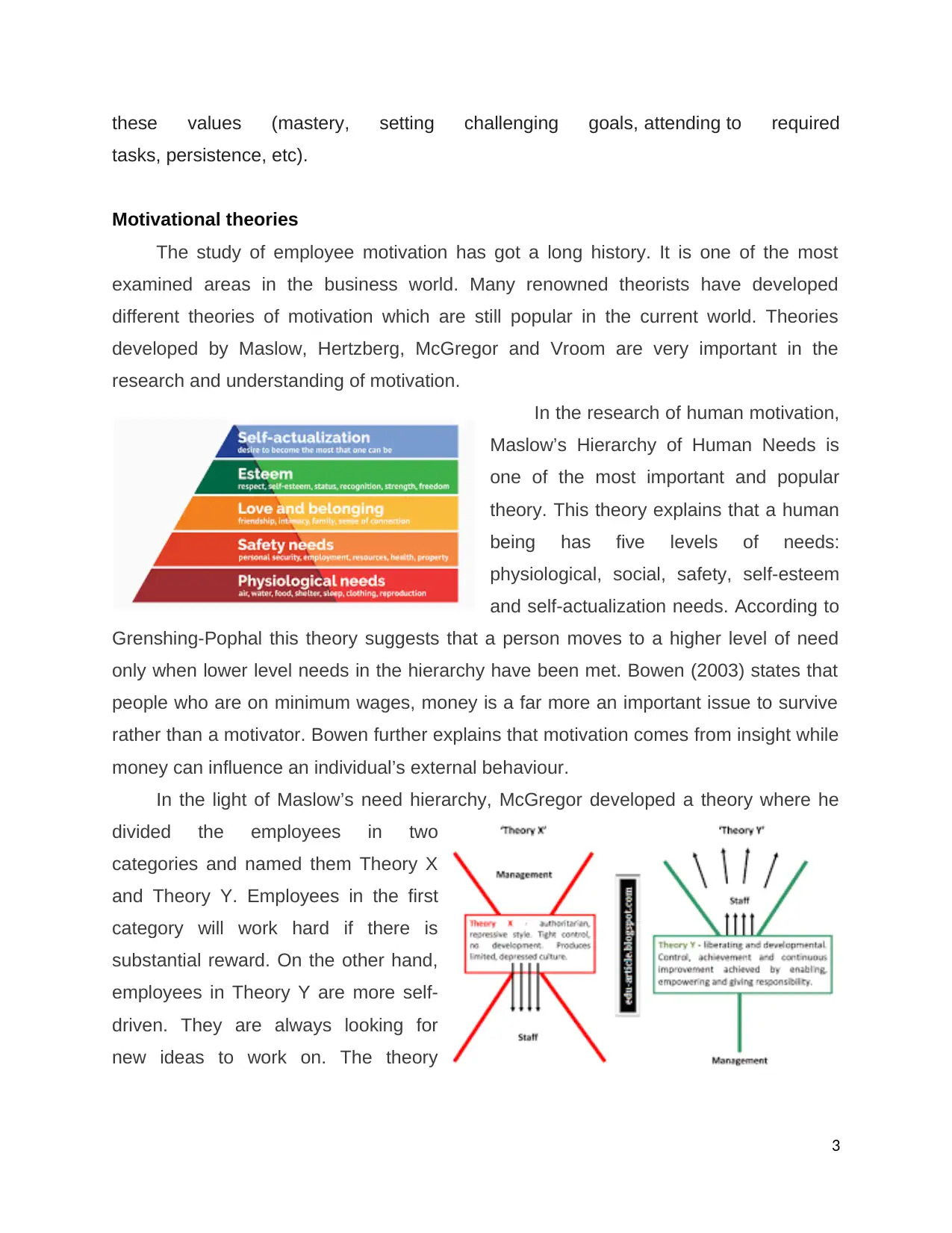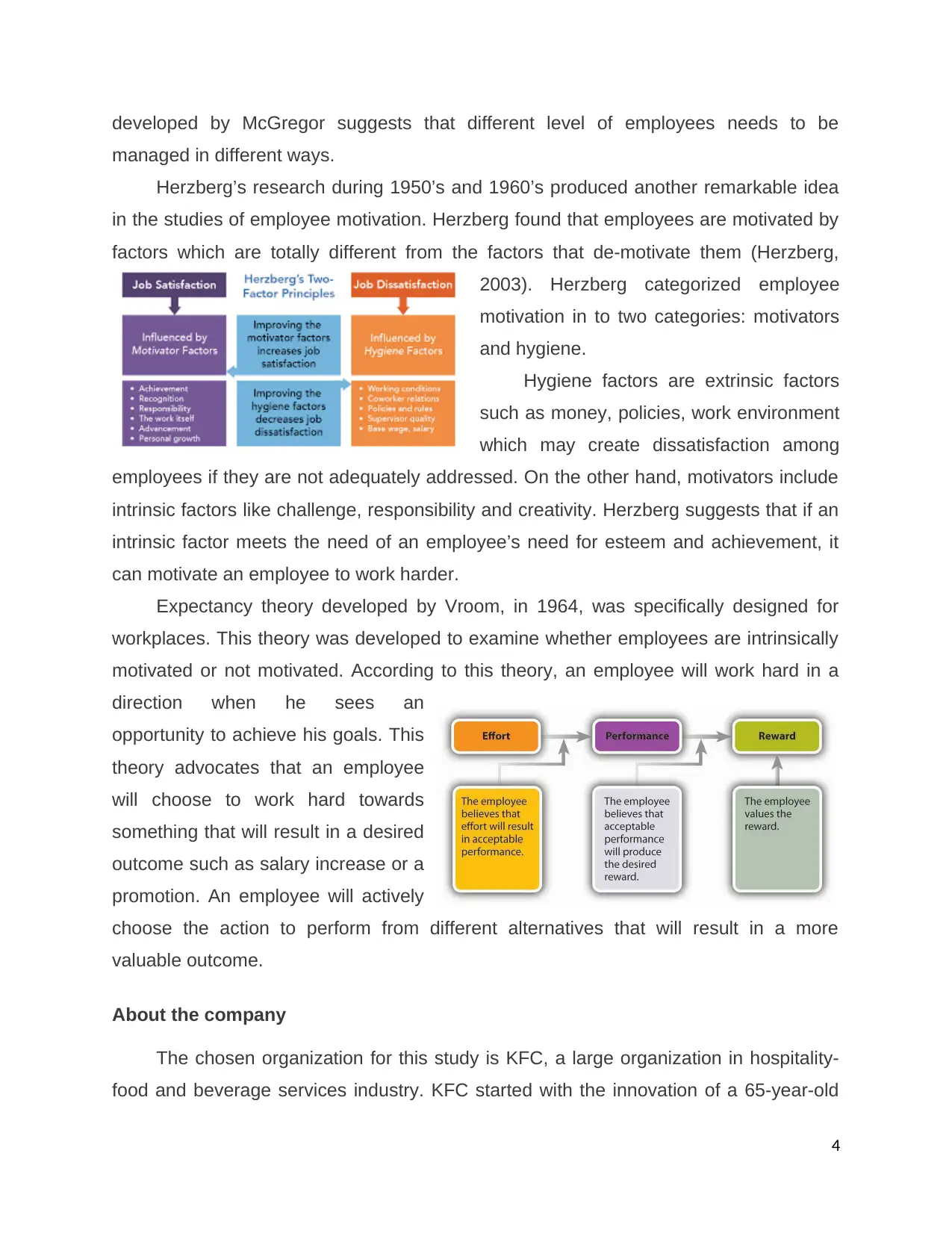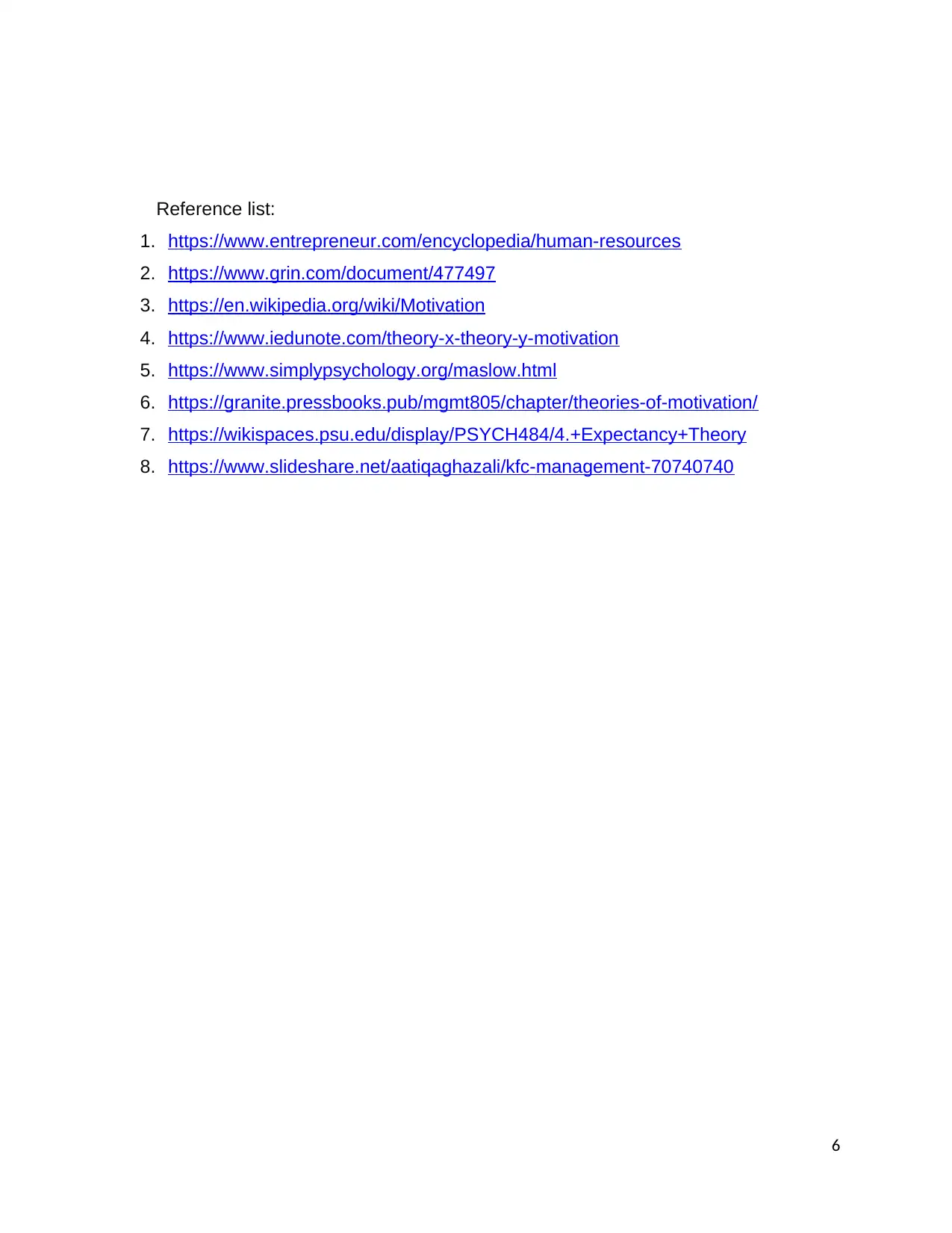HR Case Study: Analyzing Employee Motivation Strategies at KFC
VerifiedAdded on 2021/06/30
|6
|1173
|75
Case Study
AI Summary
This case study examines employee motivation within KFC, a prominent organization in the hospitality industry. The study delves into the crucial role of consistent motivation in retaining and encouraging employees to achieve both individual and organizational goals. It defines human resources and motivation, then explores various motivational theories, including Maslow's Hierarchy of Needs, McGregor's Theory X and Y, Herzberg's two-factor theory, and Vroom's expectancy theory. The case study highlights KFC's HR practices, such as one-on-one meetings, incentive programs, and reward systems like promotions and bonuses, to enhance employee engagement. The organization's history, from its origins to its recognition as a top employer, is also presented, demonstrating its commitment to fostering a positive work environment and providing development opportunities for its employees. The study concludes by emphasizing the importance of employee engagement in boosting productivity and reducing turnover within the organization.

CASE STUDY
HR – AREA OF MOTIVATION
1
HR – AREA OF MOTIVATION
1
Paraphrase This Document
Need a fresh take? Get an instant paraphrase of this document with our AI Paraphraser

INTRODUCTION
Every employee needs to be motivated constantly throughout his stay in the
organization. An employee needs to be encouraged to put his best for the organization.
He needs to be made comfortable to put all his efforts and achieve both organizational
and personal goal. Thus, it has become very essential to implement various HR policies
which support every employee and make them feel valuable. Improving employee
engagement can increase productivity and profitability while also reducing employee
absenteeism and turnover. The paper focuses on how employee engagement is an
antecedent of job involvement and what should company do to make the employees
engaged.
HR – Definition
Human resources - the department or support systems responsible for personnel
sourcing and hiring, applicant tracking, skills development and tracking, benefits
administration and compliance with associated government regulations.
A human resources department is a critical component of employee well-being in
any business, no matter how small. HR responsibilities include payroll, benefits, hiring,
firing, and keeping up to date with state and federal tax laws.
What is motivation
Motivation is the experience of desire or aversion (you want something, or want to
avoid or escape something). As such, motivation has both an objective aspect (a goal or
thing you aspire to) and an internal or subjective aspect (it is you that wants the thing or
wants it to go away).
The definition of motivation as experienced desires and aversions highlights the
association of motivation with emotion. It is believed that emotions are automatic
appraisals based on subconsciously stored values and beliefs about the object. To the
extent that distinct emotions relate to specific subconscious appraisals (e.g., anger—
injustice; guilt—violation of a moral standard; sadness—loss of a value; pride—the
achievement of a moral ideal; love—valuing an object or person; joy—the attainment of
an important value; envy—wanting the attainments of another, admiration—valuing the
attainments of another, etc.), motivation theory involves specifying "content theories"—
values that people find motivating—along with mechanisms by which they might attain
2
Every employee needs to be motivated constantly throughout his stay in the
organization. An employee needs to be encouraged to put his best for the organization.
He needs to be made comfortable to put all his efforts and achieve both organizational
and personal goal. Thus, it has become very essential to implement various HR policies
which support every employee and make them feel valuable. Improving employee
engagement can increase productivity and profitability while also reducing employee
absenteeism and turnover. The paper focuses on how employee engagement is an
antecedent of job involvement and what should company do to make the employees
engaged.
HR – Definition
Human resources - the department or support systems responsible for personnel
sourcing and hiring, applicant tracking, skills development and tracking, benefits
administration and compliance with associated government regulations.
A human resources department is a critical component of employee well-being in
any business, no matter how small. HR responsibilities include payroll, benefits, hiring,
firing, and keeping up to date with state and federal tax laws.
What is motivation
Motivation is the experience of desire or aversion (you want something, or want to
avoid or escape something). As such, motivation has both an objective aspect (a goal or
thing you aspire to) and an internal or subjective aspect (it is you that wants the thing or
wants it to go away).
The definition of motivation as experienced desires and aversions highlights the
association of motivation with emotion. It is believed that emotions are automatic
appraisals based on subconsciously stored values and beliefs about the object. To the
extent that distinct emotions relate to specific subconscious appraisals (e.g., anger—
injustice; guilt—violation of a moral standard; sadness—loss of a value; pride—the
achievement of a moral ideal; love—valuing an object or person; joy—the attainment of
an important value; envy—wanting the attainments of another, admiration—valuing the
attainments of another, etc.), motivation theory involves specifying "content theories"—
values that people find motivating—along with mechanisms by which they might attain
2

these values (mastery, setting challenging goals, attending to required
tasks, persistence, etc).
Motivational theories
The study of employee motivation has got a long history. It is one of the most
examined areas in the business world. Many renowned theorists have developed
different theories of motivation which are still popular in the current world. Theories
developed by Maslow, Hertzberg, McGregor and Vroom are very important in the
research and understanding of motivation.
In the research of human motivation,
Maslow’s Hierarchy of Human Needs is
one of the most important and popular
theory. This theory explains that a human
being has five levels of needs:
physiological, social, safety, self-esteem
and self-actualization needs. According to
Grenshing-Pophal this theory suggests that a person moves to a higher level of need
only when lower level needs in the hierarchy have been met. Bowen (2003) states that
people who are on minimum wages, money is a far more an important issue to survive
rather than a motivator. Bowen further explains that motivation comes from insight while
money can influence an individual’s external behaviour.
In the light of Maslow’s need hierarchy, McGregor developed a theory where he
divided the employees in two
categories and named them Theory X
and Theory Y. Employees in the first
category will work hard if there is
substantial reward. On the other hand,
employees in Theory Y are more self-
driven. They are always looking for
new ideas to work on. The theory
3
tasks, persistence, etc).
Motivational theories
The study of employee motivation has got a long history. It is one of the most
examined areas in the business world. Many renowned theorists have developed
different theories of motivation which are still popular in the current world. Theories
developed by Maslow, Hertzberg, McGregor and Vroom are very important in the
research and understanding of motivation.
In the research of human motivation,
Maslow’s Hierarchy of Human Needs is
one of the most important and popular
theory. This theory explains that a human
being has five levels of needs:
physiological, social, safety, self-esteem
and self-actualization needs. According to
Grenshing-Pophal this theory suggests that a person moves to a higher level of need
only when lower level needs in the hierarchy have been met. Bowen (2003) states that
people who are on minimum wages, money is a far more an important issue to survive
rather than a motivator. Bowen further explains that motivation comes from insight while
money can influence an individual’s external behaviour.
In the light of Maslow’s need hierarchy, McGregor developed a theory where he
divided the employees in two
categories and named them Theory X
and Theory Y. Employees in the first
category will work hard if there is
substantial reward. On the other hand,
employees in Theory Y are more self-
driven. They are always looking for
new ideas to work on. The theory
3
⊘ This is a preview!⊘
Do you want full access?
Subscribe today to unlock all pages.

Trusted by 1+ million students worldwide

developed by McGregor suggests that different level of employees needs to be
managed in different ways.
Herzberg’s research during 1950’s and 1960’s produced another remarkable idea
in the studies of employee motivation. Herzberg found that employees are motivated by
factors which are totally different from the factors that de-motivate them (Herzberg,
2003). Herzberg categorized employee
motivation in to two categories: motivators
and hygiene.
Hygiene factors are extrinsic factors
such as money, policies, work environment
which may create dissatisfaction among
employees if they are not adequately addressed. On the other hand, motivators include
intrinsic factors like challenge, responsibility and creativity. Herzberg suggests that if an
intrinsic factor meets the need of an employee’s need for esteem and achievement, it
can motivate an employee to work harder.
Expectancy theory developed by Vroom, in 1964, was specifically designed for
workplaces. This theory was developed to examine whether employees are intrinsically
motivated or not motivated. According to this theory, an employee will work hard in a
direction when he sees an
opportunity to achieve his goals. This
theory advocates that an employee
will choose to work hard towards
something that will result in a desired
outcome such as salary increase or a
promotion. An employee will actively
choose the action to perform from different alternatives that will result in a more
valuable outcome.
About the company
The chosen organization for this study is KFC, a large organization in hospitality-
food and beverage services industry. KFC started with the innovation of a 65-year-old
4
managed in different ways.
Herzberg’s research during 1950’s and 1960’s produced another remarkable idea
in the studies of employee motivation. Herzberg found that employees are motivated by
factors which are totally different from the factors that de-motivate them (Herzberg,
2003). Herzberg categorized employee
motivation in to two categories: motivators
and hygiene.
Hygiene factors are extrinsic factors
such as money, policies, work environment
which may create dissatisfaction among
employees if they are not adequately addressed. On the other hand, motivators include
intrinsic factors like challenge, responsibility and creativity. Herzberg suggests that if an
intrinsic factor meets the need of an employee’s need for esteem and achievement, it
can motivate an employee to work harder.
Expectancy theory developed by Vroom, in 1964, was specifically designed for
workplaces. This theory was developed to examine whether employees are intrinsically
motivated or not motivated. According to this theory, an employee will work hard in a
direction when he sees an
opportunity to achieve his goals. This
theory advocates that an employee
will choose to work hard towards
something that will result in a desired
outcome such as salary increase or a
promotion. An employee will actively
choose the action to perform from different alternatives that will result in a more
valuable outcome.
About the company
The chosen organization for this study is KFC, a large organization in hospitality-
food and beverage services industry. KFC started with the innovation of a 65-year-old
4
Paraphrase This Document
Need a fresh take? Get an instant paraphrase of this document with our AI Paraphraser

man named Colonel Harland Sanders in 1939. He started selling his original recipe fried
chicken from a petrol station he owned. However, he had to move on the roads to sell
his chicken due to a construction work that bypassed his town. This resulted in the first
KFC outlet being opened in 1952 in Utah and started a great successful journey. In
2011, KFC became one of the top 50 great places to work in United Kingdom and
ranked as one of Britain’s top employers by CRF Institute. KFC got this award for
having great HR practices of international standard and ensuring a great work
environment and development opportunities.
To enhance employee motivation, KFC is using one to one meetings strategy, they
have staff incentive programs, conventions, etc. KFC reward their employees in terms
of promotion, incentive, payoff free meals depending on the level of the employee and
how much they perform their job well. Bounces are given to the employees based on
“my growth body” points. If the person has 5 points, he or she can get benefits in term of
financial bonuses.
5
chicken from a petrol station he owned. However, he had to move on the roads to sell
his chicken due to a construction work that bypassed his town. This resulted in the first
KFC outlet being opened in 1952 in Utah and started a great successful journey. In
2011, KFC became one of the top 50 great places to work in United Kingdom and
ranked as one of Britain’s top employers by CRF Institute. KFC got this award for
having great HR practices of international standard and ensuring a great work
environment and development opportunities.
To enhance employee motivation, KFC is using one to one meetings strategy, they
have staff incentive programs, conventions, etc. KFC reward their employees in terms
of promotion, incentive, payoff free meals depending on the level of the employee and
how much they perform their job well. Bounces are given to the employees based on
“my growth body” points. If the person has 5 points, he or she can get benefits in term of
financial bonuses.
5

Reference list:
1. https://www.entrepreneur.com/encyclopedia/human-resources
2. https://www.grin.com/document/477497
3. https://en.wikipedia.org/wiki/Motivation
4. https://www.iedunote.com/theory-x-theory-y-motivation
5. https://www.simplypsychology.org/maslow.html
6. https://granite.pressbooks.pub/mgmt805/chapter/theories-of-motivation/
7. https://wikispaces.psu.edu/display/PSYCH484/4.+Expectancy+Theory
8. https://www.slideshare.net/aatiqaghazali/kfc-management-70740740
6
1. https://www.entrepreneur.com/encyclopedia/human-resources
2. https://www.grin.com/document/477497
3. https://en.wikipedia.org/wiki/Motivation
4. https://www.iedunote.com/theory-x-theory-y-motivation
5. https://www.simplypsychology.org/maslow.html
6. https://granite.pressbooks.pub/mgmt805/chapter/theories-of-motivation/
7. https://wikispaces.psu.edu/display/PSYCH484/4.+Expectancy+Theory
8. https://www.slideshare.net/aatiqaghazali/kfc-management-70740740
6
⊘ This is a preview!⊘
Do you want full access?
Subscribe today to unlock all pages.

Trusted by 1+ million students worldwide
1 out of 6
Related Documents
Your All-in-One AI-Powered Toolkit for Academic Success.
+13062052269
info@desklib.com
Available 24*7 on WhatsApp / Email
![[object Object]](/_next/static/media/star-bottom.7253800d.svg)
Unlock your academic potential
Copyright © 2020–2025 A2Z Services. All Rights Reserved. Developed and managed by ZUCOL.




